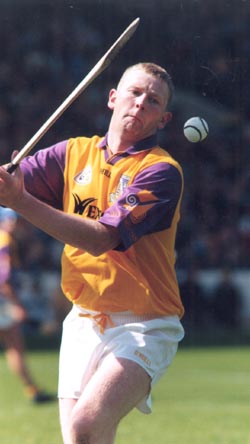(Taken from Hogan Stand magazine – 15th November 1991)
By JIMMY GEOGHEGAN
Wexford has never being short of its famous sporting families. There was, during the 40’sand the 50’s, the Rackard brothers. Later it was the Dorans and then the Quigleys. Now, another name can be added to that illustrious list – the Fitzhenry’s.
While the Dorans and the Rackards and the Quigley’s have become famous for their exploits with the sliotar and the camain, it is with the bigger ball that the Fitzhenry brothers have being making their own distinctive mark.
For they have not only succeeded in helping their club monopolise the football Championship in Wexford, they have also played their part in getting Duffry Rovers to the semi-final of the Leinster Championship, where they play Clara, having already collected the scalps of clubs from Kildare and Louth on the way.
Over the past ten years the name Filzhenry has become as closely associated with Duffry Rovers as Christmas is with December. Altogether, ten brothers have lined out for the club at one time or another, making their contribution to an amazing sequence of success. From the eldest brother Mark, who is in his mid-thirties and who has retired from football, to the youngest Damian, who is just seventeen, the Fitzhenry’s have become accustomed to providing nearly half the players for their club’s fixtures. In between these two, Tom, Seamus, John, Martin, Gerard, Noel~ Paddy and Fran have lined out for the Rovers. But it doesn’t just end there. Three sisters, Tina, Mary and Ann have played camogie for Duffry, with Tina gaining a regular place on the Wexford team, helping the Model County to All-lreland camogie runners-up place in 1990.
Some of the brothers have also shown that they possess that extra bit of pace and skill that is the stuff of the intercounty players. At present three brothers, Seamus, Martin and Noel, are members of the Wexford football team, while both Seamus and Martin have been regular members of the Model County Senior hurling team at various intervals over the past few years.
But the man with the most inter-county experience is Seamus, who at 31, is looked upon as one of the ’elder’ members of the family. For over ten years now, he has been a regular choice on the Wexford football side, first making his appearance for the south-east county in 1979, when he was only 19 years of age. The relative young age, at which he grabbed the attention of the county selectors, points to precocious and considerable talent that, in a different more successful football environment, could have helped to make him one of the household names of modern gaelic football.
According to Duffry Rovers Chairman, Paddy Foley, he is a player that could, and still can, hold his own with the best. ‘If Seamus had been with any of the big footballing counties such as Dublin or Kerry, he would be known throughout the country by now. He is a player very much in the Pat Spillane mould. A strong, fast player, who is also very skillful. A great asset to any side.’
But Fitzhenry’s skills in football largely remained hidden in the lower divisions and in the drearily monotonous defeats in the first rounds of the Championships. But despite being a part of one of the weaker footballing counties, Searnus Fitzhenry holds many fond memories of games in the famous Yellow Belly shirt. ‘Our defeat of Dublin in a League game during the ’85/86 season was a great moment for us. I would say that it was the best performances given by Wexford in a very long time, and made sweeter by the fact no-one had expected us to win.’
Another moment was winning the goal of the year award after he was captured in camera sending a proverbial piledriver to the Croke Park net in a Championship match against Dublin – a game that he believes Wexford could have won.
But Seamus Fitzhenry’s experiences of Croke Park on big match day has not been confined to occasional appearances with the footballers. Since the mid eighties, he has been a permanent member of the Wexford Senior hurling squad. His last excursion with the Model County to the Mecca of gaelic sport was in the summer or ’91 when Wexford played Kilkenny in the Leinster final. It was a game that the men in purple and yellow looked to have won up until the last seconds when Eamonn Morrissey kicked a ball to the net to give the Cats a late, late, winner. It was a crushing moment for Seamus Fitzhenry, who had came on as a substitute. ‘It was a terribly disappointment to lost the way we did that day. We should have had it wrapped up long before the end but we let it slip. We thought that we had done enough to win. Now it will be harder for us to make the breakthrough in the future. We have some very good players but I just wonder if we have enough’, he says.
But the bitter blow inflicted on such occasions has been mitigated somewhat by the recent remarkable march to success by the Duffry Rovers team. In October they made sporting history in Wexford by becoming the first team to win six senior county championships, beating Glynn -Barntown 2-6 to 0-5 in the final. In the Rovers line-up that day was six Fitzhenry’s. Half-back, John, Midfielder Paddy, half-forwards Noel and Fran, with both Ger and Seamus operating on the full-forward line.
For Ger Fitzhenry the game was a truly memorable occasion. Not only because he won the man-of-the-match award but also because he scored the two goals that provided the platform for his team’s victory. The goals had come in each half helping to kill-off Glynn-Barntown, who have had to suffer the pain of being beaten by Duffry Rovers in the final for the third year in a row.
Throughout the game, Fran Fitzhenry had proved a scourge for the Glynn-Barntown defence, with his dangerous runs that continually threatened to yield a rich harvest for his team. Both his goals came from passing movements that included two of his brothers. The first and most spectacular goal came in the opening five minutes of the match when Fran Fitzhenry picked up a pass from team-mate Ger O’Connor and sent it In to his brother Ger, who moved towards the goal before crashing it past the startled Glynn-Barntown goalkeeper. The second that came early in the third quarter, resulted from a piece of quick thinking by his brother Seamus who received a pass from Aidan Jordan before lobbing a ball over the head of an advancing defender that allowed Ger Fitzhenry the time and space to neatly tuck the ball into the Glynn-Barntown net.
Throughout most of the game Duffry Rovers never looked like a team that was going to be denied their unique place in history. That county final triumph has been followed by victories over Kildare side, Clane and Stabannon Parnells from Louth in the Leinster championship, earning them a place in the semi-finals against Clara. It is a sequence of results that Seamus Fitzhenry is aware has a deep significance for both his club and county. ‘No Wexford club has ever gotten to the semi-final of the Leinster championship before. But we would like to go a little bit further than that and maybe even go on and win it. Once you get to a final anything can happen. But even getting this far could give a great boost to football in Wexford generally. If we can get this far why not the county side’.
It is a truly remarkable and impressive achievement for a tiny club that operates from a small parish located at the foot of Mt. Leinster, 10 miles outside Enniscorthy.
Up to fifteen years ago Duffry Rovers were to be found playing out of the junior ranks in football. Hurling had traditionally been the strongest sport in the area but, gradually Rovers began to diversify, winning the Intermediate football championship in 1980 and moved up into ranks of the senior clubs for the first time.
In 1984 and ’85 the Rovers were beaten in the county final and semi-final respectively but in 1986 it all came right for the club as they gathered the first of their six county championships.
Both Seamus Fitzhenry and Chairman Foley hold various theories as to why a club such as Duffry Rovers can work their way from a nondescript junior side to one of the top teams in Leinster.
According to Seamus Fitzhenry the transformation has been partly due to fortuitous amalgamation of factors. ‘I think that we have been very lucky in getting a panel of very good players just at the same time and being able to hold on to them. We haven’t been affected as much as other teams by emigration so we have operated from roughly the same panel of players. A settled team has been very important to us’.
In the view of Paddy Foley the foundation for the present day success had been laid back in the ’70’s and ’80’s through the fostering and development of a vigorous youth policy. ‘Since the early seventies when Fr. Harry Synnot started organising the young players, the club has placed a strong emphasis on the under-age teams and this has borne fruit down the years. I think the health of any club can be judged by the amount of young people coming up through the ranks’.
The go-ahead nature of Duffry Rovers has also been exhibited in the employment of Englishman Robert Brakewell, as trainer. His experience in coaching the Enniscorthy rugby team has proved very useful in turning the Rovers in one of the fittest sides around. The club has also shown its innovative nature by the appointment in the ’80’s of a local woman, Josie Foley, as chairwoman of the club. Surely another first.
But while success on the football front has become commonplace for Duffry Rovers in recent times a long cherished hurling championship has continued to elude the Fitzhenry’s and their team-mates. Not since 1928 has a team from the parish won the senior hurling championship. This summer the Rovers were beaten by Faythe Harriers in the semi-final of the county championship. Almost the exact set of players’ lined out for the Rovers in both codes with only an odd positional change made to accommodate the needs of each game. Damien Fitzhenry for instance, usually plays in goals for the club for the hurling but moves to the half-forward line for the football game.
He will be occupying that position when Duffry Rovers take on Clara in Leinster club semi-final. And despite the absence of brothers Fran and Martin and colleague Pat O’Leary, all of whom are working in the Middle East, he and the rest of his brothers. along with key players such as Louise Rafter, Jay Mernagh and John Casey, an outstanding half back who was team captain on each of those six historic occasions, will open another glorious chapter in the recent and remarkable history of Duffry Rovers and the Fitzhenry family.


